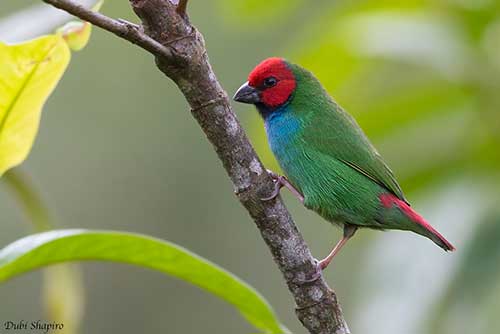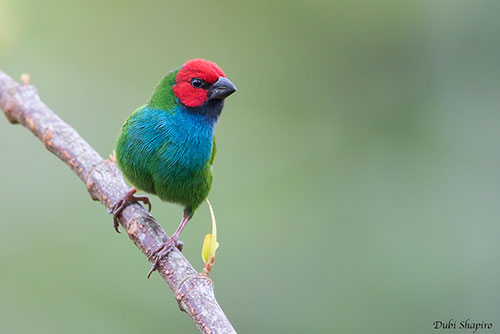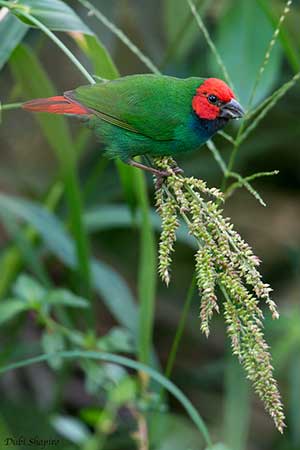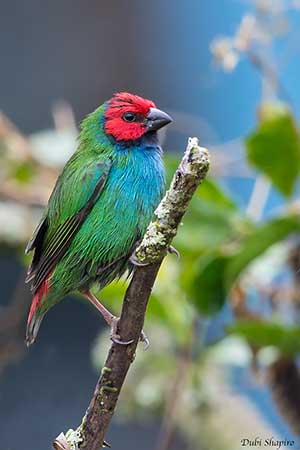
PROTECTION / THREATS / STATUS:
The Fiji Parrotfinch is described as uncommon to locally common throughout the range. It has adapted well to man-made landscapes and is not currently threatened by degradation of the habitat for agriculture or by deforestation. It may be affected by introduced rodents during the nesting period, because these animals are able to access the nests.
But currently, the population appears to be stable and the Fiji Parrotfinch is evaluated as Least Concern.
Fr: Diamant de Peale - Diamant de Peal - Diamant des Fidji
Ang: Fiji Parrotfinch
All: Fidschipapageiamadine
Esp: Diamante de Fiji
Ita: Diamante delle Figi
Nd: Fijipapegaaiamadine
Sd: fijiamadin
Photographer:
Dubi Shapiro
Dubi Shapiro Photo Galleries & Dubi Shapiro's Pictures on IBC
Text by Nicole Bouglouan
Sources:
HANDBOOK OF THE BIRDS OF THE WORLD Vol 15 by Josep del Hoyo-Andrew Elliot-David Christie - Lynx Edicions – ISBN: 9788496553682
L’ENCYCLOPEDIE MONDIALE DES OISEAUX - Dr Christopher M. Perrins - BORDAS - ISBN: 2040185607
Wikipedia, the free encyclopaedia
Bird Watching on Fiji – aladdin.st – Fiji Parrotfinch
BirdyInfo - Information About the Bird Fiji Parrotfinch
Revolvy.com - Fiji parrotfinch
Home page
Page Passeriforme Order
Fiji Parrotfinch
Erythrura pealii
Passeriformes Order – Estrildidae Family
INTRODUCTION:
The Fiji Parrotfinch was described first by the American naturalist and entomologist Titian Peale. Its first name was Geospiza prasina, but later, the German physician and ornithologist Gustav Hartlaub moved the species to the genus Erythrura and renamed the bird as Erythrura pealii, in honour of its finder.
The Fiji Parrotfinch was formerly treated as a subspecies of the Samoan Erythrura cyaneovirens, but it is now a full species endemic to Fiji.
This small, bright-coloured bird usually frequents forest edge and gardens, although it has expanded into grassy areas where it feeds on seeds.
The Fiji Parrotfinch is described as uncommon to locally common, and the species is not currently globally threatened.

DESCRIPTION OF THE BIRD:
Biometrics:
Length: 10 cm
Weight: 10-11 g
The Fiji Parrotfinch adult male has bright green plumage on body and wings. Head, rump and tail are scarlet.
On the underparts, the chin is black, turning dark blue on the throat and mostly turquoise on the upper breast. Rest of underparts is green.
The heavy bill is blackish-grey. The eyes are dark reddish-brown. Legs and feet are pale pinkish.
The female resembles male but she is usually duller, with less extended red colour on head, especially on crown.
The juvenile resembles adult but it has yellow bill with dark tip, and the face is mostly bluish, gradually turning red. It gains the adult plumage at about 20 months.
RANGE:
The Fiji Parrotfinch is endemic to Fiji where it occurs on several islands such as Vanua Levu, Taveuni, Viti Levu, Kadavu and Mamanuca and Yasawa Groups.

HABITAT:
The Fiji Parrotfinch is found in both forested and open habitats from sea-level to at least 1,200 metres of elevation on Viti Levu. This species has adapted to man-made habitats. It frequents forest edges, grasslands, pastures, parks and gardens.
CALLS AND SONGS: SOUNDS BY XENO-CANTO
The sounds uttered by parrotfinches are often harsh and discordant and usually contain short notes. The call of the Fiji Parrotfinch is a high “seep” or “peep”. This call can be repeated in series of variable length. The song is a long whistle of two notes. The Fiji Parrotfinch calls frequently while flying and during the aerial displays.
BEHAVIOUR IN THE WILD:
The Fiji Parrotfinch feeds on seeds of Megathyrsus maximus (family Poaceae) that grows in open grasslands. It also forages for seeds in ricefields and visits gardens.
It catches insects and spiders found under loose bark or in wood crevices. In some areas, if feeds on small berries and nectar. However, grass seeds are the main part of its diet.
It often feeds on the ground. Outside breeding season, it can be seen in small groups of 5-6 individuals.

The Fiji Parrotfinch performs aerial displays above treetops. Both male and female perform an oscillating flight during which one bird is ascending while the second bird is descending. They call continuously during the flight display.
Then, both mates land on a branch and other type of display occurs. They lock their bills before the female hangs upside-down during a variable period of time. These displays are followed by copulation.
During the displays, the bright-coloured plumage pattern, and especially the red head, rump and tail, are enhanced by adapted postures accompanied by calling.
The Fiji Parrotfinch is sedentary, with some movements between nearby islands.
This species has fast, undulating flight with rapid wingbeats.
REPRODUCTION OF THIS SPECIES:
The breeding season is probably similar to that of the Samoan E. cyaneovirens, in January/April and July/August.
The Fiji Parrotfinch builds a domed nest with side entrance, usually hidden in thick foliage. This structure is made with fresh grass blades, and can be placed at various heights above the ground.
The female lays 4 whitish eggs. The chicks are naked with pink skin and hatch after 13-14 days of incubation.
They have a distinctive gape with blue papillae or tubercles at upper and lower corners, and yellow palate with a ring of five black spots. These elaborate markings and colours help the parents to feed the young. They can see these visual patterns while the chick begs for parental attention, and acts as a signal value to the adults. In addition, this behaviour may reduce competition for food between nestlings.
The young fledge 18-21 days after hatching, and are independent two weeks later.
